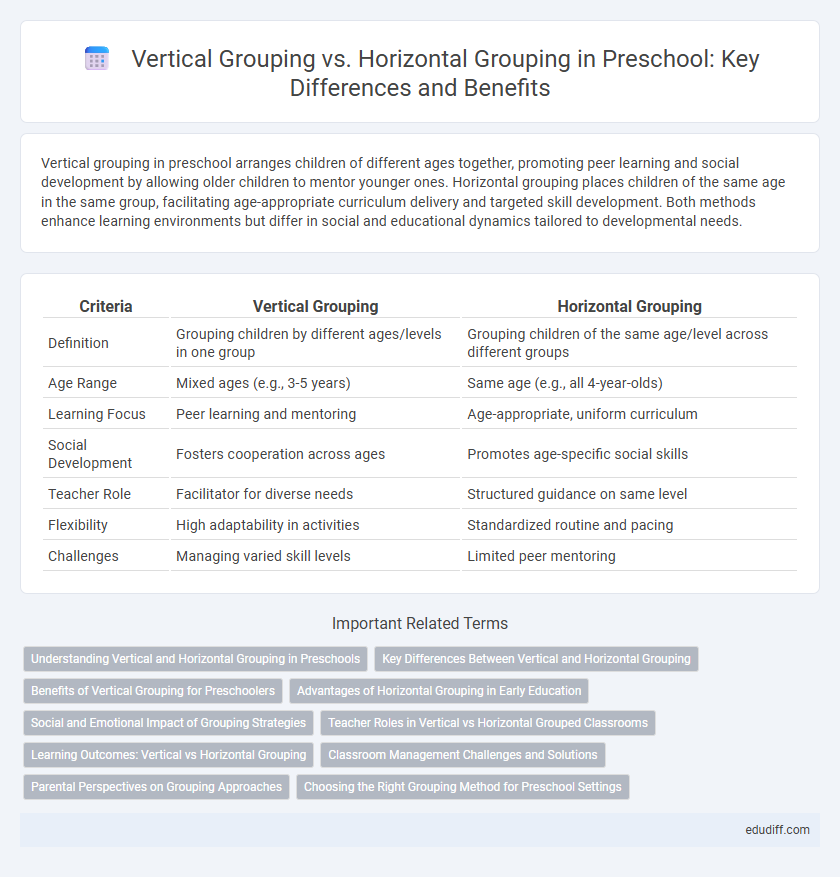Vertical grouping in preschool arranges children of different ages together, promoting peer learning and social development by allowing older children to mentor younger ones. Horizontal grouping places children of the same age in the same group, facilitating age-appropriate curriculum delivery and targeted skill development. Both methods enhance learning environments but differ in social and educational dynamics tailored to developmental needs.
Table of Comparison
| Criteria | Vertical Grouping | Horizontal Grouping |
|---|---|---|
| Definition | Grouping children by different ages/levels in one group | Grouping children of the same age/level across different groups |
| Age Range | Mixed ages (e.g., 3-5 years) | Same age (e.g., all 4-year-olds) |
| Learning Focus | Peer learning and mentoring | Age-appropriate, uniform curriculum |
| Social Development | Fosters cooperation across ages | Promotes age-specific social skills |
| Teacher Role | Facilitator for diverse needs | Structured guidance on same level |
| Flexibility | High adaptability in activities | Standardized routine and pacing |
| Challenges | Managing varied skill levels | Limited peer mentoring |
Understanding Vertical and Horizontal Grouping in Preschools
Vertical grouping in preschools involves organizing children of different ages together, promoting peer learning and social development across age ranges. Horizontal grouping sorts children by similar age or skill levels, enabling targeted curriculum delivery and developmental appropriateness. Choosing between vertical and horizontal grouping impacts classroom dynamics, individualized instruction, and social interactions in early childhood education settings.
Key Differences Between Vertical and Horizontal Grouping
Vertical grouping in preschool organizes children by age or developmental stage, promoting age-appropriate curriculum and peer interactions. Horizontal grouping arranges children of different ages together based on skill level or interest, encouraging heterogeneous learning and socialization. Key differences include age homogeneity in vertical grouping versus mixed-age interaction in horizontal grouping, impacting teaching strategies and social development outcomes.
Benefits of Vertical Grouping for Preschoolers
Vertical grouping in preschool settings promotes social-emotional development by allowing children of different ages to interact and learn from one another. Older preschoolers develop leadership skills, while younger ones benefit from peer modeling and increased language acquisition. This method also fosters a sense of community and continuity, supporting individualized learning paces and reducing competition among same-age peers.
Advantages of Horizontal Grouping in Early Education
Horizontal grouping in early education supports social development by grouping children of the same age, fostering peer interaction and collaborative learning. This approach allows teachers to tailor instruction to a specific developmental stage, enhancing curriculum relevance and engagement. Consistent grouping promotes stronger relationships among children, contributing to a positive classroom environment and emotional security.
Social and Emotional Impact of Grouping Strategies
Vertical grouping in preschool settings fosters cross-age peer interaction, enhancing empathy and social skills by allowing older children to model positive behaviors for younger peers. Horizontal grouping supports age-appropriate emotional development by enabling children to engage with peers at similar developmental stages, promoting a sense of belonging and reducing social anxiety. Both strategies impact the social-emotional environment, where vertical grouping encourages mentorship and emotional regulation, while horizontal grouping reinforces peer bonding and cooperative play.
Teacher Roles in Vertical vs Horizontal Grouped Classrooms
Teacher roles in vertically grouped classrooms involve managing diverse age ranges, tailoring instruction to multiple developmental stages, and facilitating peer learning across ages. In horizontally grouped classrooms, teachers focus on delivering age-specific, uniform curriculum and addressing similar cognitive and social needs within the peer group. Effective classroom management and differentiated instruction strategies vary significantly between these grouping methods to optimize student engagement and learning outcomes.
Learning Outcomes: Vertical vs Horizontal Grouping
Vertical grouping in preschool settings enhances learning outcomes by allowing mixed-age peer interactions, fostering mentorship, and supporting individualized development trajectories. Horizontal grouping, involving same-age peers, promotes age-appropriate social skills and curriculum pacing, enabling targeted cognitive and emotional growth. Studies indicate vertical grouping can accelerate personalized learning, while horizontal grouping strengthens peer bonding and reinforces standardized developmental milestones.
Classroom Management Challenges and Solutions
Vertical grouping in preschool often presents classroom management challenges such as diverse developmental needs and varying attention spans among children of different ages. Solutions include tailored instruction strategies, differentiated activities, and flexible seating arrangements to accommodate individual learning paces. In contrast, horizontal grouping simplifies management by clustering children of similar age, allowing uniform lesson plans but requiring strategies like rotational activities to maintain engagement and address occasional behavioral issues.
Parental Perspectives on Grouping Approaches
Parents often perceive vertical grouping in preschools as beneficial for fostering mentorship and social skills development across age groups, as it allows older children to model positive behaviors for younger peers. Conversely, some parents prefer horizontal grouping, valuing the uniformity in developmental stages that supports tailored curriculum pacing and peer interaction among children of the same age. Surveys indicate that parental preferences can significantly influence preschool enrollment decisions, highlighting the importance of transparent communication about grouping approaches.
Choosing the Right Grouping Method for Preschool Settings
Vertical grouping in preschool combines children of different ages, fostering peer learning and social development, while horizontal grouping organizes children by the same age or skill level, promoting targeted instruction and consistency. Selecting the right grouping method depends on the preschool's educational goals, classroom dynamics, and individual child needs. Balancing vertical and horizontal grouping can enhance developmental outcomes by accommodating diverse learning paces and encouraging collaboration.
Vertical grouping vs Horizontal grouping Infographic

 edudiff.com
edudiff.com